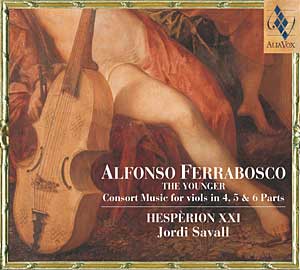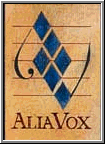|
Alfonso Ferrabosco
The Younger (circa 1575-1628)
Consort Music for Viols in 4, 5 & 6
Parts |
|
Consort Music, vol. IV |
|
Alia Vox AV9832
Code-barres/Barcode:
7619986098326 |
|
|

|
Description
Artistes / Performers
Hespèrion XXI, dir.Jordi Savall,
Sophie Watillon, Sergi Casademunt, Imke
David, Philippe Pierlot, Lorenz Dufschmid, Xavier Diaz-Latorre
Lieu d'enregistrement / Recording site:
Collégiale du Château de Cardona (Catalogne / Catalunya)
Dates d'enregistrement: 12-2002
et 02-2003
Recording dates: Dec.
2002 & Feb. 2003
Durée totale / Total time: 66'00'' |
|
|
 |
|
 Illustration
de la pochette du disque:
Illustration
de la pochette du disque:
Le
Tintoret (1518-1594)
"Femmes jouant" - Huile sur toile, 142 x 214 cm,
|
 Artwork of the CD jacket:
Artwork of the CD jacket:
Tintoretto: (1518-1594)
"Wowen playing music" Oil on canvas, 142 x 214 cm,
|

Cliquer pour agrandir / Click to enlarge
|
|
Évaluations recensées / Reviews
located |
|

03/2004
(SEE BELOW) |

#
510
04-2004
VOIR CI-DESSOUS |

# 5902-2004
VOIR CI-DESSOUS |
|

28:1 (09-10/2004)
(SEE BELOW)
|
|
|
|

Alfonso Ferrabosco Le Fils
(ca. 1575-1628) |

Alfonso Ferrabosco the younger
(ca. 1575-1628) |
|

Extrait du livret / From the liner notes |
|
 Alfonso Ferrabosco Le Fils (v.1575-1628)
appartient à une longue dynastie de musiciens. Son père, Alfonso
Ferrabosco I, italien d’origine, avait traversé l’Angleterre
élisabéthaine avec talent en redynamisant une société anglaise
tombée dans l’apathie, en y important des techniques musicales
venues d'Italie. Le jeune Ferrabosco Le Fils, compositeur,
gambiste, luthiste et chanteur, va commencer par devoir assumer la
tâche difficile d’être comparé à ce père illustre. S’il entre à la
cour royale dès 1592, il va lui falloir près de dix ans pour
mettre en évidence ses talents et capter l’attention de la Reine,
période qui lui sera finalement utile, car elle donnera à son
œuvre cette forme incomparable.
Alfonso Ferrabosco Le Fils (v.1575-1628)
appartient à une longue dynastie de musiciens. Son père, Alfonso
Ferrabosco I, italien d’origine, avait traversé l’Angleterre
élisabéthaine avec talent en redynamisant une société anglaise
tombée dans l’apathie, en y important des techniques musicales
venues d'Italie. Le jeune Ferrabosco Le Fils, compositeur,
gambiste, luthiste et chanteur, va commencer par devoir assumer la
tâche difficile d’être comparé à ce père illustre. S’il entre à la
cour royale dès 1592, il va lui falloir près de dix ans pour
mettre en évidence ses talents et capter l’attention de la Reine,
période qui lui sera finalement utile, car elle donnera à son
œuvre cette forme incomparable.
Il fit partie de l’ensemble royal de violes à partir de
1601 et à la mort d’Elisabeth Ière en 1603, son successeur
Jacques IV nomma Ferrabosco professeur de Henry,
Prince-de-Galles. Ferrabosco continue à travailler au
service du roi, deviendra compositeur de la Musique du Roi
en 1625 et musicien officiel de la Cour en 1626 (succédant à
John Coprario), deux ans avant de mourir. Le respect
témoigné à son égard par ses contemporains prouve que
Ferrabosco fut bien LE musicien de la cour de son temps, et
le fait qu’il fut le plus copié en est une autre preuve.
Ferrabosco inaugure véritablement le baroque anglais...
|
|
 Alfonso Ferrabosco the younger
(ca.1575-1628) came from a long line of musicians. His talented,
Italian-born father, Alfonso Ferrabosco, had a meteoric career in
Elizabethan England, where he gave a new zest to apathetic English
society by importing musical techniques from Italy. The first
major hurdle that confronted his son, the young Ferrabosco, who
was a composer, violist, lutenist and singer, was being held up
for comparison with his illustrious father.
Alfonso Ferrabosco the younger
(ca.1575-1628) came from a long line of musicians. His talented,
Italian-born father, Alfonso Ferrabosco, had a meteoric career in
Elizabethan England, where he gave a new zest to apathetic English
society by importing musical techniques from Italy. The first
major hurdle that confronted his son, the young Ferrabosco, who
was a composer, violist, lutenist and singer, was being held up
for comparison with his illustrious father.
Although he gained access to the royal court as early as 1592, it
took him almost 10 years to prove his worth and come to the
attention of the queen. It turned out to be a fruitful period,
however, in which he forged the incomparable form of his musical
works. In 1601 he became a member of the royal consort of viols,
and when Elizabeth I died in 1603, her successor James IV
appointed Ferrabosco as music teacher to Henry, Prince of Wales.
Ferrabosco continued to work in the king's service, becoming
Composer of the King's Music in 1625 and in 1626, two years before
his death, succeeding John Coprario in the post of official court
musician. The respect shown for him by his contemporaries proves
that Ferrabosco was the court musician of his day, as is further
borne out by the fact that he was the most copied.
Ferrabosco marks the true beginning of the English Baroque...
|
|
Gramophone-
03/2004 |
GRAMOPHONE
ARCHIVE
|
Subscription
Abonnement |
Analyste: Fabrice
Fitch
Extraits - en traduction libre
Fabrice Fitch se dit déçu que ce disque consacré exclusivement à
Ferrabosco le Jeune ne constitue pas la révélation attendue.
Fitch dit de Ferrabosco fils que « même s’il est un compositeur plus
habile (slicker) que son père, … sa musique gagne à être interprétée
dans un environnement tout en contraste. En elle-même, sa musique
paraît quelque peu monotone et ne mérite pas un enregistrement d’une
durée d’une heure ». « Ce qu’on nous présente ici, poursuit Fitch,
est bien agréable… », mais on aurait souhaité « un programme plus
étoffé, autre chose en fait que cette sélection plutôt
superficielle ».
|
Reviewer: Fabrice
Fitch
The spotlight falls on Ferrabosco the
Younger but does he merit the attention?
|
|
Diapason- # 510
04-2004 |
|
Appréciation
5 diapason
Evaluation |
Abonnement
Subscription |
Analyste: Denis
Morrier
Résumé ou abrégé:
Denis Morrier souligne la grande qualité d’interprétation d’Hespèrion
XXI qui « … aborde avec son excellence coutumière ce répertoire
exigeant : homogénéité des timbres, sonorités somptueuses, justesse
impeccable, phrasé élégant mais incisif et d’une grande souplesse
dynamique, empli de raffinements d’articulation et d’expression ».
Il exprime toutefois l’opinion qu’à l’écoute de cette musique « …
l’ennui peut menacer, suscité non par l’interprétation mais par le
répertoire… ».
Pour Morrier, Ferrabosco se situe « … aux antipodes des innovations
compositionnelles et expressives de Dowland et autres Humes ». Il
ajoute : « Les inconditionnels de la viole (et de Jordi Savall ne le
manqueront sous aucun prétexte… ». |
Reviewer: Denis
Morrier
Abridged version :
Denis Morrier underlines the high quality of these performances by
Hespèrion XXI.
These musicians “… approach this demanding repertoire with their
habitual excellence: homogeneity of tones, sumptuous sonorities,
elegant phrasing nevertheless incisive and yet having a lot of
dynamic flexibility, full of subtleties…”. He adds, however, there
is a risk one could be bored, not by the interpretations per se but
by the repertory. According to Morier, Ferraboso is at the extreme
opposite of Dowland and Humes with their compositional and
expressive innovations.
He concludes his review in these terms: “Those absolute lovers of
the viola da
gamba (and of Jordi Savall) won’t want to miss this recording”. |
|
Classica- # 59
(02-2004) |
 |
Appréciation:

Evaluation:
|
Abonnement
Subscription |
Analyste: Stéphan Perreau
Résumé ou abrégé:
Nous voici en compagnie de Savall et de ses fidèles amis musiciens
(Sergi Casademunt, Sophie Watillon, Philippe Pierlot, Lorenz
Duftschmid) qui reviennent visiter le répertoire du consort de
viole. Après Coprario, Purcell, Jenkins, Holborne et Lawes, voici
que Savall nous présente sa vision d’un autre compositeur anglais
« … adulé de la période élisabéthaine ». Stéphan Perreau souligne
dans le cas de cet enregistrement « la complicité des musiciens »
qui n’aurait, à son dire, « … rien perdu de son évidence ». Il
ajoute : « Mieux, les années passant, elle se montre à nous comme
une bouleversante intimité dévoilée…. Tout est aisance, fluidité des
lignes, verticalité sans reproches possibles, technique pure
d’instruments maîtrisés à la perfection. Confondant. »
|
|
Reviewer: Stéphan
Perreau
Abridged version :
We find Savall
accompanied on this CD by some of his faithful musician friends (Sergei
Casademeunt, Sophie Watillon, Philippe Pierlot, Lorenz Duftschmid).
They are revisiting the repertoire of consort music for viols. After
his interpretation of the works of Coprario, Purcell, Jenkins,
Holborne and Lawes, Savall brings us his vision of another English
composer “… extremely well known during the Elizabethan period.” The
reviewer, Stephan Perreau, stresses the fact that in the case of this
recording “… the complicity of the musicians is again fully evident.”
“As years go by,
it is even more evident. One needs only listen to this Fantasia
no. 14 from the Four-Part Fancies, brilliantly exuberant
or melancholic, moving without any effort. Everything is flowing
with ease, the lines are fluid, … an example of pure technique, with
instruments being perfectly mastered.”
Perreau concludes: “Astounding.” |
|

28:1 (09-10/2004)
|
 |
|
Abonnement
Subscription |
Reviewer: Brian Robins
Excerpt:
Ferrabosco was especially renowned for his fantasias, which exerted
a strong influence on succeeding generations of English consort
composers. Savall has concentrated on these masterfully wrought
contrapuntal pieces, giving us no less than 12 of those in four
parts, pieces particularly skilled in this respect. I have to
confess that, for all their undoubted qualities, I do not find them
particularly ingratiating listening. To my ears, there is a kind of
restless aridity about much of this music, which, for me lacks that
element of romantic intensity and drama found a little later in the
fantasias of William Lawes. Perhaps I’m not sufficiently familiar
with the music at present, or possibly Hesperion’s performances are
just not persuasive enough. It would be interesting to hear what
light Fretwork or Phantasm might throw on Ferrabosco II.
Read
on... |
|
|
La Musique / The Music |
| I.
Five-Part Dances Dovehouse Pavan
Almaine
II. Four-Part Fancyes
Fantasia No. 14
Fantasia No. 4
Fantasia No. 2
Fantasia No. 8
III. Five- & Six-Part Consorts
In Nomine a 5
Fantasia No. 3 a 6
|
IV.
Four-Part Fancyes Fantasia No. 24
Fantasia No. 5
Fantasia No. 7
Fantasia No. 9
V. Five- & Six-Part Consorts
Four-Note Pavan
Fantasia No. 2 a 6
|
VI.
Four-Part Fancyes Fantasia No. 6
Fantasia No. 1
Fantasia No. 10
Fantasia No. 3
VII. Six-Part Consorts
In Nomine a 6
Fantasia No. 6 a 6
|
|
|
|
Autres références disponibles via la base de
données de Todd McComb/ Other available references via
Todd McComb's database:
(Site: http://www.medieval.org)
Re:
AV9832
 Articles fort intéressants à propos
de la viole de gambe:
Articles fort intéressants à propos
de la viole de gambe:
"La
vie après la mort ~ La viole de gambe au XVIIIème siècle"
par
Peter Holman
Paru dans: Goldberg, # 42 (Octobre 2006, pp. 48-58) |
|
|
|
|
|
To order / Pour commander
Alia Vox AV9832
Code-barres/Barcode:
7619986098326
|
|
Sélectionnez votre
pays et votre devise en accédant
à Presto Classical
(Bouton en haut à droite)
Livraison mondiale |

|
Choose your country
and curency when reaching
Presto Classical
(Upper right corner)
Worldwide delivery |
|
|
La viole de
gambe
Parutions
récentes |
Viola da gamba
Recent
releases |








